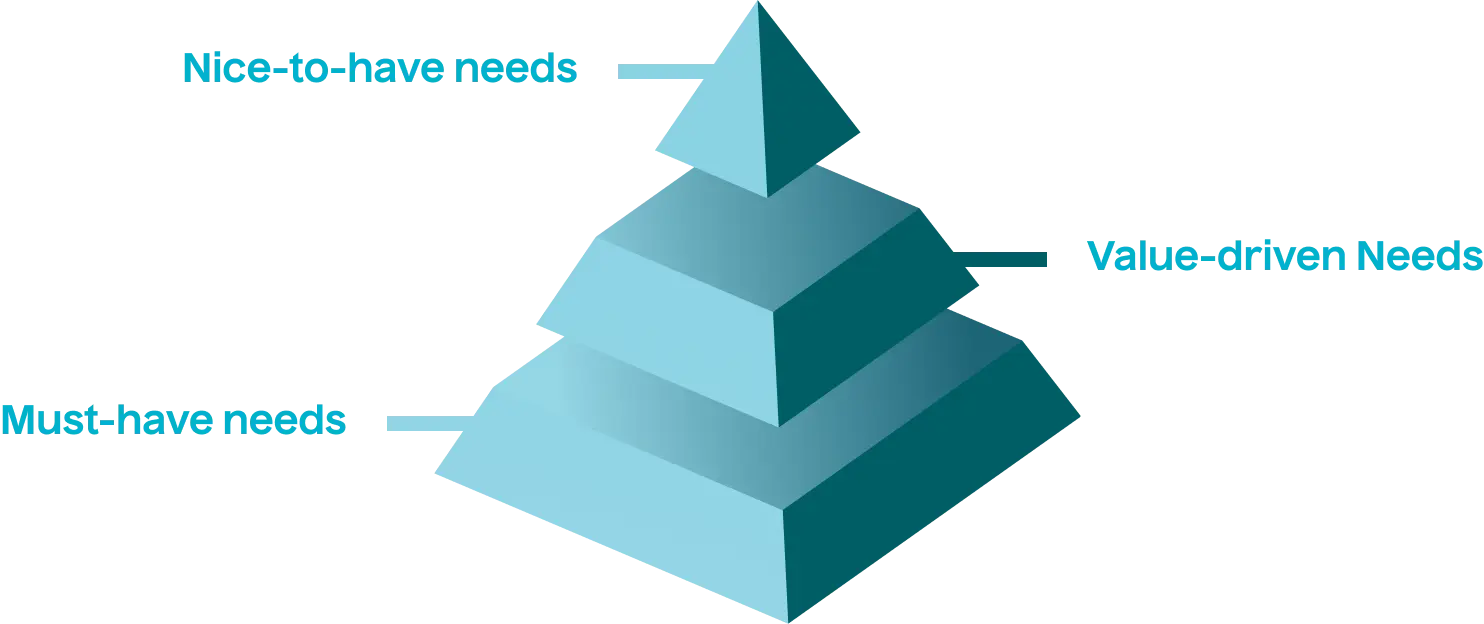The typology of evaluation needs:
collection of data points
It is crucial for sales organizations to understand how satisfaction levels, needs and expectations are interlinked. All buyer-seller relationships are based on expectations. The buyer’s expectations can turn into explicit (known) needs. Managing the customer expectations in a right way will most likely result in a satisfied customer. Remember to have a proper segmentation in place, so that the expectations can be met, and slightly overachieved. Moreover, it is important to work on the expectations that you are being evaluated on, as we have seen with the supplier scorecard. Anything on top of that is a nice-to-have and is unknown to the buyer. A shared concern from the purchasing side is that the sales is paying too much focus on the nice-to-haves, while there is still a lot of room for improvement for the must-have and value-driven needs.
In the next paragraphs, we will share more about how the buyer is looking at how essential the must-have need; how the value-driven needs correlate with performance; and how the nice-to-have needs are only the icing on the cake. This triangle is similar to the Maslow hierarchy of needs in the way that you need to have the needs of the bottom of the pyramid in place before you can tackle the higher positioned needs.

Must-have needs
The must-have needs are a license to operate, and should be made available and updated by the sales side, without any hurdles for the buying organization. As an exampl, Zoho created an overview of all their certificates of compliance, GDPR, security, etc. The must-have evaluation needs often include the financial strength of a vendor, and the proof that they are in good relationship with social security and taxes. This could also include the level of dependency of vendor firm on the one of the buyer’s organization. Some purchasing organizations allow a maximum of i.e. 30% turnover dependency of the vendor firm to reduce supply risks. Second in the must-have evaluation needs are the necessary certifications that include e.g. the ISO norms and the industry-specific certificates. Not to forget the compliance, and the increasingly important sustainability impact measures. The must-have needs can also be linked to laws, industry standards, and other elements that are not part of the discussion. Without satisfying these needs, there is no business. Our suggestion is to make these files easily accessible for the buyer.
Value-driven Needs
Before we started the analysis, we were expecting to find a pattern in the evaluation metrics or performance indicators used by both sides, but the findings showed us differently. Here are the main differences when it comes to evaluating the external organization.
The value-driven or performance needs for buyers are, to our surprise, very hard to generalize. The reason why they are so hard to generalize is because they are strongly influenced by the nature of business environment: the countries of operation, the industry, the macro influences, the level of competition, the company-specific strategy, the importance of the sales offer, the business criticality, and so many more. The key take-away is that it is not possible to have a one-size-fits-all set of performance measures. However, we could identify the following set of groups of evaluation types:
- Satisfaction and feedback
- Performance and strategy
- Quality
- Relationship
- Financials
- Risk
- Sustainability
- Events
- Operational
- Compliance and legal
- Innovation
- Support and issues
The evaluation type or review approach ‘satisfaction and feedback’ could be measured by the following evaluation methods: quarterly or annual business reviews (QBR, ABR); customer satisfaction scores (CSAT); evaluation forms; focus group discussions; notes; satisfaction interviews; customized satisfaction surveys; Net Promotor Score (NPS); self-assessments on satisfaction; verbal comments; etc.
In order not to overwhelm you with more than one hundred possible evaluation methods for all the evaluation types, we synthesize the main idea for you: one method is not enough. Buyers are using advanced techniques to evaluate the performance of their vendors (you!), such as supplier performance scorecards. They benchmark your performance to the one of your competitors, and calibrate the findings from different stakeholders. Thus, sales organizations should level up their approach, and not only seek a quick confirmation. Building relationships depends on a proper understanding of the counterpart’s needs and goals. One simple evaluation method will most likely be insufficient to capture all of this
Nice-to-have needs
Finally, the nice-to-have needs are not really needs because they are not expected by the buyer. There are a few rules to follow when you want to deliver on these excitement needs for your buyer. First of all, it is necessary to have the basic needs in place, and they should be always accessible for the buyer, followed by a good execution of the sales offer that fulfills the performance needs as much as possible for a given segment. Managing customer expectations is vital to improve customer satisfaction for the value-driven needs. But only when those two types of needs are met, you can bring out your potential to meet the nice-to-have needs.


